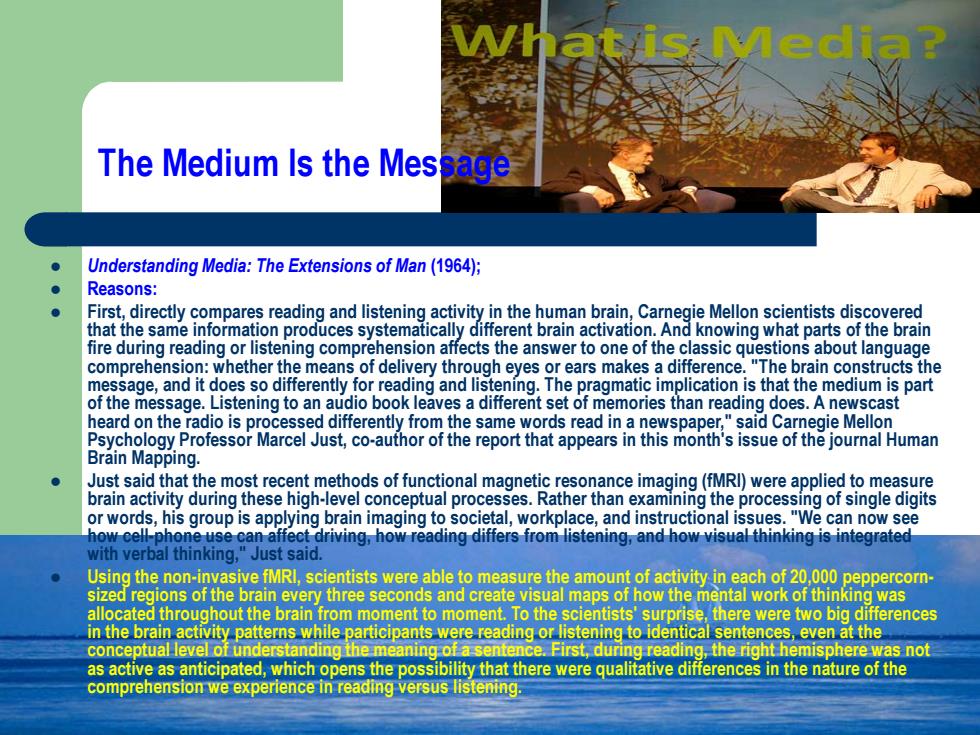正在加载图片...

atis Media? The Medium Is the Message Understanding Media:The Extensions of Man(1964); Reasons: First,directly compares reading and listening activity in the human brain,Carnegie Mellon scientists discovered that the same information produces systematically different brain activation.And knowing what parts of the brain fire during reading or listening comprehension affects the answer to one of the classic questions about language comprehension:whether the means of delivery through eyes or ears makes a difference."The brain constructs the message,and it does so differently for reading and listening.The pragmatic implication is that the medium is part of the message.Listening to an audio book leaves a different set of memories than reading does.A newscast heard on the radio is processed differently from the same words read in a newspaper,"said Carnegie Mellon Psychology Professor Marcel Just,co-author of the report that appears in this month's issue of the journal Human Brain Mapping. Just said that the most recent methods of functional magnetic resonance imaging(fMRl)were applied to measure brain activity during these high-level conceptual processes.Rather than examining the processing of single digits or words,his group is applying brain imaging to societal,workplace,and instructional issues."We can now see how cell-phone use can affect driving,how reading differs from listening,and how visual thinking is integrated with verbal thinking,"Just said. Using the non-invasive fMRI,scientists were able to measure the amount of activity in each of 20,000 peppercorn- sized regions of the brain every three seconds and create visual maps of how the mental work of thinking was allocated throughout the brain from moment to moment.To the scientists'surprise,there were two big differences in the brain activity patterns while participants were reading or listening to identical sentences,even at the conceptual level of understanding the meaning of a sentence.First,during reading,the right hemisphere was not as active as anticipated,which opens the possibility that there were qualitative differences in the nature of the comprehension we experience in reading versus listening. Understanding Media: The Extensions of Man (1964); Reasons: First, directly compares reading and listening activity in the human brain, Carnegie Mellon scientists discovered that the same information produces systematically different brain activation. And knowing what parts of the brain fire during reading or listening comprehension affects the answer to one of the classic questions about language comprehension: whether the means of delivery through eyes or ears makes a difference. "The brain constructs the message, and it does so differently for reading and listening. The pragmatic implication is that the medium is part of the message. Listening to an audio book leaves a different set of memories than reading does. A newscast heard on the radio is processed differently from the same words read in a newspaper," said Carnegie Mellon Psychology Professor Marcel Just, co-author of the report that appears in this month's issue of the journal Human Brain Mapping. Just said that the most recent methods of functional magnetic resonance imaging (fMRI) were applied to measure brain activity during these high-level conceptual processes. Rather than examining the processing of single digits or words, his group is applying brain imaging to societal, workplace, and instructional issues. "We can now see how cell-phone use can affect driving, how reading differs from listening, and how visual thinking is integrated with verbal thinking," Just said. Using the non-invasive fMRI, scientists were able to measure the amount of activity in each of 20,000 peppercorn- sized regions of the brain every three seconds and create visual maps of how the mental work of thinking was allocated throughout the brain from moment to moment. To the scientists' surprise, there were two big differences in the brain activity patterns while participants were reading or listening to identical sentences, even at the conceptual level of understanding the meaning of a sentence. First, during reading, the right hemisphere was not as active as anticipated, which opens the possibility that there were qualitative differences in the nature of the comprehension we experience in reading versus listening. The Medium Is the Message